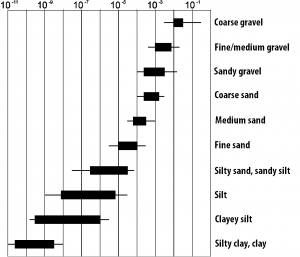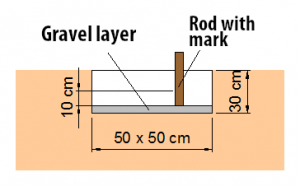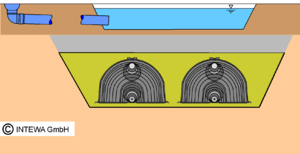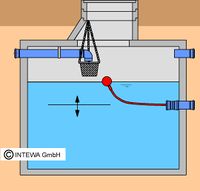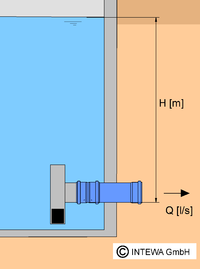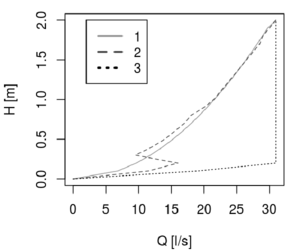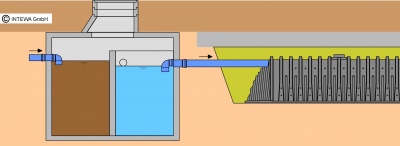Versickerung und Retention/en: Unterschied zwischen den Versionen
(Die Seite wurde neu angelegt: „{| class="wikitable" "text-align:rechts" |- ! Duration D [min] !! Rain yeld r [l/sha] !! L<sub>erf,rigole</sub> [m] !! V<sub>erf,rigole</sub> [m³] |- | 5 || 2…“) |
(Die Seite wurde neu angelegt: „''c. TTable for rough estimation of small systems with r<sub>15,n=0.2</sub>'' {| class="wikitable" |- ! k<sub>f</sub> (m/s) !! !! colspan="3"| e.g. location Aa…“) |
||
| Zeile 593: | Zeile 593: | ||
|} | |} | ||
| − | ''c. | + | ''c. TTable for rough estimation of small systems with r<sub>15,n=0.2</sub>'' |
{| class="wikitable" | {| class="wikitable" | ||
|- | |- | ||
| − | ! k<sub>f</sub> (m/s) !! !! colspan="3"| | + | ! k<sub>f</sub> (m/s) !! !! colspan="3"| e.g. location Aachen (D) r<sub>15,0.2</sub>=152.6 L/(s*ha)!! colspan="3"|e.g. location Berlin (D) r<sub>15,0.2</sub>=213.1 L/(s*ha) |
|- | |- | ||
| || || A=100 m<sup>2</sup> || A=150 m<sup>2</sup> || A=200 m<sup>2</sup> || A=100 m<sup>2</sup> || A=150 m<sup>2</sub> || A=200 m<sup>2</sup> | | || || A=100 m<sup>2</sup> || A=150 m<sup>2</sup> || A=200 m<sup>2</sup> || A=100 m<sup>2</sup> || A=150 m<sup>2</sub> || A=200 m<sup>2</sup> | ||
|- | |- | ||
| − | | 1*10<sup>-4</sup> || | + | | 1*10<sup>-4</sup> || Volume in m<sup>3</sup> || 1.36 || 2.04 || 2.72 || 1.90 || 2.85 || 3.79 |
|- | |- | ||
| − | | 1*10<sup>-5</sup> || | + | | 1*10<sup>-5</sup> || Volume in m<sup>3</sup> || 1.49 || 2.24 || 2.99 || 2.09 || 3.13 || 4.79 |
|- | |- | ||
| − | | 1*10<sup>-6</sup> || | + | | 1*10<sup>-6</sup> || Volume in m<sup>3</sup> || 1.51 || 2.26 || 3.02 || 2.11 || 3.16 || 4.21 |
|} | |} | ||
Version vom 9. November 2018, 13:29 Uhr
In water management, experience asserts that rainwater should be infiltrated at the place where it accumulates. If this is not possible, then in many cases the temporary storage (attenuation or retention) of rainwater is required in attenuation volumes in order to protect the drainage systems from overloading and to limit their dimension.
Advantages of rainwater infiltration
For final consumers:
- sealing costs are saved
- the microclimate on site is improved
For municipalities:
- lower flood protection / flood prevention costs
- lower costs in sewer construction, sewer rehabilitation and sewage plant operation
- lower development costs for new estates
- securing of the groundwater supply
Advantages of rainwater retention:
- limiting regional flowing off, reducing flood risk
- lower costs in sewer construction, sewer rehabilitation and sewage plant operation
- connection of new estates to existing, working at full capacity drainage systems
- relief of overloaded sewer systems
Basic principles
Quality of rainwater runoff
The runoff from paved surfaces are classified into the categories of non-hazardous, tolerable and intolerable according to their material concentration and thereby possibly associated potential hazards to groundwater in targeted rainwater infiltration.
Non-hazardous rainwater runoff
Non-hazardous rainwater runoff can be infiltrated (e.g. in trenches) without pretreatment measures through the unsaturated zone (below the root zone and above the groundwater level).
Tolerable rainwater runoff
Tolerable rainwater runoff can be infiltrated through the unsaturated zone after suitable pretreatment or using cleaning processes (sedimentation system, rainwater cisterns, overgrown soil, etc.).
Intolerable rainwater runoff can only be infiltrated after pretreatment.
| Surface / Area | Qualitative evaluation |
|---|---|
| Green roofs, fields and cultivated land; roof surfaces without the use of uncoated metals (copper, zinc and lead), terrace surfaces in residential and similar commercial areas | non-hazardous |
| Roofs with usual proportions of uncoated metals, cycle tracks and footpaths in residential areas, calm traffic areas; lawns and car parking without frequent vehicle changes; as well as lightly used vehicle areas (up to DTV 300 vehicles); streets with DTV 300 - 5,000 vehicles, e.g. access roads, residential and district streets; airport tarmac; roofs in commercial and industrial areas with significant air pollution, see DWA-A138. | tolerable |
| Lawns and streets in commercial and industrial areas with significant air pollution; for special zones see DWA | intolerable |
Source DWA-A138, DTV = average daily traffic intensity
Soil composition
Infiltration capacity of the soil
The underground composition is of crucial importance for rainwater infiltration. The permeability coefficient (kf-value) is a measure of water permeability of the soil. The permeability coefficient should be between 10-3 and 10-6 in order to ensure the functionality of the infiltration system.
In order to avoid over-dimensioning of the system, the kf-value should be determined as accurately as possible through investigation. There are professional geotechnical experts for this purpose.
Quick test for soil composition
If the kf-value is unknown, then an approximation of the underground infiltration can be isolated based on the following short test.
- Dig a 50 x 50 cm wide and approx. 30 cm deep pit. Important: Do not enter the pit to avoid compression!
- Cover the soil with a gravel layer to prevent soil flotation. Insert a measuring rod into the ground. 10 cm above the pit bottom place a mark on the measuring rod.
- Now fill the pit with water and replenish for 1-2 hours regularly (e.g. garden hose).
- Fill water up to the mark. After 10 minutes, fill as much water as necessary to raise the water level back to the mark using a measuring bucket. The soil permeability can be estimated from the quantity of refilled water.
- Repeat step 4 as many times (at least 3 times), until a consistent value is established.
Evaluation:
Water quantity < 1.5 litres in 10 minutes: little infiltration possible (silt)
Water quantity = 1.5 litres in 10 minutes: infiltration possible (silty sand)
Water quantity > 3 litres in 10 minutes: good infiltration possible (sand, gravel)
Cleaning options for precipitation water
The contamination of underground and surface water from rainwater from roofs and traffic areas can be considered qualitatively and quantitatively by using simple assessment procedures (ATV DVWK-M153). Depending on the result, various measures for handling rainwater must be taken to ensure adequate water protection.
For discharge into a trench, minimum protection requires coarse filtration.
- Important: with rainwater harvesting cisterns
According to DIN 1989-1, underground infiltrations systems (trenches) are equivalent to infiltration systems in active soil areas in terms of qualitative aspects, provided the inlet water comes from a rainwater harvesting system with non-metallic roof areas.
Sedimentation and filter chamber, sedimentation systems
Systems with a settling chamber in which the flow conditions allow specific substances heavier than water sink and specific lighter substances float are referred to as sedimentation systems.
Collection and filter chambers consist of a sedimentation area in which heavy particles settle and a filter that prevents light coarse contaminants from entering the downstream storage. Even light materials are retained in the chamber with an immersion pipe. Depending on the amount of dirt, they must be cleaned regularly. The total water discharged from roof is filtered and supplied to the tank. In Germany the chambers are designed in accordance with ATV DVWK-M153, corresponding to the expected amount of dirt and connected roof area.
Soil passages
Contaminants from flowing rainwater are retained and stored or degraded by physical, chemical and if necessary, biological processes with passage through soil layers or in trough-trench systems or unsealed surfaces such as grass pavers. Thus passage through overgrown topsoil is more effective than through a non-vegetated soil zone. The protective cover layers over groundwater must not be penetrated.
Flushable and camera-accessible trenches
Should contaminants penetrate into the trench despite pre-cleaning, it is very important that subsequent cleaning is possible. In many trenches e.g. box systems, only the flushing ducts can be cleaned afterwards. However fine contaminates pass through the slots in the flushing ducts and gradually clog the floors and walls of these trenches. Ultimately these can only be dug out completely if they have lost their infiltration capacity. With DRAINMAX Tunnel trenches for example, the critical walls and floors can be inspected with a camera through adequate connection chambers and are completely flushable. Contaminants either are retained in the coarse filter of the sedimentation and filter chamber or settle in the sedimentation area. The coarse filter can be removed and emptied after the flushing process. The parallel rows of trenches are additionally protected by the long settling section in the seepage pipe and the additional settling possibility in the inspection and flushing chamber. This guarantees a constant infiltration performance long-term.
Construction of an infiltration system
- Distance to MHGW (mean highest groundwater level) from the bottom of the system: > 1 m
- Soil permeability > 1 x 10-6 (with lower values see retention)
- Soil permeability < 1 x 10-3 (with higher permeability too little treatment)
Trench infiltration with DRAINMAX Tunnel
| 1. DRAINMAX Tunnel | 5. Topsoil |
| 2. Tunnel side and top backfill | 6. Sedimentation/filter chamber |
| 3. Geotextile | 7. Rainwater inlet |
| 4. Tunnel overburden |
Mulden-Rigolenversickerung mit DRAINMAX Tunnel
| 1. DRAINMAX Tunnel | 6. Infiltration trough |
| 2. Tunnel side and top backfil | 7. Rainwater inlet |
| 3. Geotextile | 8. Distance to groundwater |
| 4. Tunnel overburden | 9. Active soil zone |
| 5. Topsoil | 10. Maximum water level |
DRAINMAX Tunnel System for commercial properties
| 1. DRAINMAX Tunnel | 7. Sedimentation/filter chamber |
| 2. Tunnel side and top backfill | 8. Flushing chamber |
| 3. Geotextile | 9. Rainwater inlet |
| 4. Tunnel overburden | 10. Maximum water level |
| 5. Topsoil | 11. Geotextile composite bottom layer |
| 6. Rainwater distribution |
Construction of a retention system
Retention volume
There are several options for the retention of rainwater:
- Storage with pure retention and throttle discharge
- Storage with combined retention and use and throttle discharge
The combination of rainwater harvesting and rainwater retention in a cistern is particularly interesting for smaller systems for single-family homes since the costs for excavation and delivery are incurred only once and the cistern is not significantly more expensive.
- Retention with approved partial infiltration and throttle discharge
With permissible partial infiltration, the DRAINMAX system with tunnel elements is an extremely interesting alternative. The low height offset between inlet and outlet in combination with great space flexibility and a very high storage volume are the advantages of this variant. If no water is allowed to enter the surrounding soil from the system, it can be sealed with an EPDM foil on site.
| 1. DRAINMAX Tunnel | 6. Topsoil |
| 2. Tunnel side and top backfill | 7. Sedimentation/filter chamber |
| 3. Geotextile | 8. Throttle chamber |
| 4. Enclosed sheet basin made from EPDM and geotextile | 9. Discharge throttle |
| 5. Tunnel overburden | 10. Rainwater inlet |
Throttle discharge
In a retention system the water is supplied into the drainage system with a throttled flow rate. The throttle discharge corresponds to the permitted outflow of the sealed area connected to the drainage system. Most of the time this discharge corresponds to the natural flow before sealing the area.
In the retention system the permissible throttle discharge is either supplied to a downstream drainage system by means of a lift pump or through a discharge throttle provided the height conditions allow. According to DWA-A 117, the arithmetic average of the values of the throttle curve is to be set for uncontrolled throttling (fixed throttle/vortex throttle).
Compared to the vortex or fixed throttle, continuous throttles make sure that the maximum permitted water quantity Q drains constantly, irrespective of the impounding depth H. As a result, the retention tank with continuous throttle can be dimensioned by 10% to 30% smaller than with fixed throttle discharge or vortex throttles.
Exp. throttle curve for maximum admissible water quantity of 31 L/s
1. Fixed throttle (arithmetic mean = 21 L/s)
2. Vortex throttle (arithmetic mean = 21 L/s)
3. Continuous discharge throttle (31 L/s)
Fixed throttle
The simplest form of a fixed or static throttle is a simple flow restrictor. The discharge value Q of the fixed throttle depends on the hydrostatic pressure resulting from the impounding depth H.
Vortex throttle
A spiral stream of variable strength with a central rotating air core is formed by the tangential feed in the vortex throttle depending on the water level. However this does not lead to a continuous throttle outflow. The vortex throttle has the advantage of requiring less space and lower risk of blockages due to the larger remaining cross-section compared to the other throttle types. These advantages are rarely relevant with decentralized rainwater retention.
Continuous throttle
The outlet flow is constant with the continuous discharge throttle irrespective of the impounding depth H. The float adjusts the restrictor opening at the impounding depth by means of a lever arm. Coarse pre-cleaning of rainwater is necessary for the trouble-free operation of the throttle.
Calculation example of required storage volume
The crucial rain yield rD(n), the duration D and frequency n [L/s-ha] must be determined iteratively (see Dimensioning of infiltration or retention systems).
| Verf = ((Ared x rD(n) x 10-4) – Qdr ) x D x 60 x 10-3 | |
| Verf | = required storage volume in m³ |
| Ared | = connected paved surfaces in m² (5,000 m² in example) |
| rD(n) | = crucial rainfall in L/s-ha (e.g. KOSTRA-Data Aachen, see Dimensioning of infiltration or retention systems) |
| Qdr | = discharge throttle value in L/s (the arithmetic mean of the throttle curve with non-continuous throttles, see diagram of throttle curves, 21 L/s in the example) |
| D | = Duration in min (in example, 30 min with the fixed throttle and vortex throttle, 20 min with the continuous throttle) |
| fixed throttle = vortex throttle: Verf = ((5,000 x 104.8 x 10-4) – 21) x 30 x 60 x 10-3 = 56.6 m³ | |
| continuous throttle: Verf = ((5,000 x 131.7 x 10-4) – 31) x 20 x 60 x 10-3 = 41.8 m³ (- 26 %) | |
The larger the permitted throttle outflow in relation to the connected areas, the greater the difference. This difference leads to correspondingly lower total costs for the retention system.
Dimensioning of infiltration or retention systems
Also see Online Planner
Rainwater runoff
The calculation of rainwater runoff is based on the knowledge that heavy rains last short durations and low rains persist for longer. The rainfall yield declines at the same statistical frequency with increasing rainfall duration. The relationship between rainfall yield, duration and frequency is determined by the statistical analysis of precipitation registrations. Simple calculation methods in Germany are used in accord with DWA-A 117. For this a statistical rainfall with selected duration D and frequency n should be used as load case for calculation. For the determination of rain yield refer to the "amount of heavy peak rainfall in Germany - KOSTRA" (see table for a sample location).
| Rain duration D | r D(1) l/(s*ha) | r D(0,2) l/(s*ha) |
|---|---|---|
| 5 min | 135.0 | 243.0 |
| 10 min | 113.0 | 183.9 |
| 15 min | 97.2 | 152.6 |
| 20 min | 85.3 | 131.7 |
| 30 min | 69.5 | 104.8 |
| 45 min | 52.9 | 81.2 |
| 60 min | 43.1 | 66.8 |
| 90 min | 32.3 | 49.7 |
| 2 h | 26.4 | 40.3 |
| 3 h | 19.8 | 29.9 |
| 4 h | 16.1 | 24.3 |
| 6 h | 12.1 | 18.0 |
| 9 h | 9.1 | 13.4 |
| 12 h | 7.4 | 10.9 |
| 18 h | 5.4 | 7.9 |
| 24 h | 4.3 | 6.5 |
| 48 h | 2.6 | 3.7 |
| 72 h | 2.1 | 2.9 |
KOSTRA data sample location
Inflow to infiltration or retention systems
- Qzu = 10-7 x rD(n) x Ared (1.)
| Qzu | = Inflow to infiltration system in m³/s |
| rD(n) | = Rain yield for duration D and frequency n [L/s-ha] |
| Ared | = connected paved areas in m² |
Discharge from the infiltration system
Darcy’s Law is used to calculate the discharge from an infiltration system:
- Qs = (b+0,5h) x L x ½ x kf (2.a)
| kf | = Permeability coefficient of the saturated soil in m/s |
| b | = Bottom width of the trench in m |
| h | = Height of the trench in m |
| L | = Length of the trench in m |
Discharge from the retention system
- Qs = QD (2.b)
| QD | = Throttle discharge in the case of a retention system |
Continuity condition
- Verf = L x b x h x sRR = (∑Qzu - ∑Qs) x D x 60 (3.)
| Verf | = required storage volume in m³ |
| D | = Rain duration in min |
Infiltration: If only formulas 1. and 2.a are used for formula 3 to calculate L, then this will result in a significant trench length and volume.
SRR = Storage coefficient of the trench
Retention: Here, only formulas 1. and 2.b are used in formula 3. Ver = (∑Qzu - ∑Qs) x D x 60 The significant rain yield rD(n) of duration D and frequency n [L/s-ha] must be iteratively determined.
Overflow frequency
For statistical determination of rainwater outflows, the assumed frequency of rain from the rain yield curve is crucial. This value depends on the economic importance of the area and is related to the frequency with which the proposed system is congested.
| Frequency of dimensioning system (once in n years) | Location |
|---|---|
| 1 in 1 | Rural area |
| 1 in 2 | Residential area |
| 1 in 2 | City centers, industrial and commercial areas with flood assessment |
| 1 in 5 | City centers, industrial and commercial areas without flood assessment |
| 1 in 10 | Underground traffic infrastructure, subways |
Source: ATV A118
Überflutungsnachweis DIN 1986-100:2016-09 (Deutschland)
Entwässerungsanlagen für die Ableitung des Niederschlagswassers von kleinen Grundstücken können, soweit der Kanalnetzbetreiber keine anderen Vorgaben macht, ohne Überflutungsprüfung bemessen werden. Als klein gelten Grundstücke mit bis zu 800 m² abflusswirksamer Fläche, für die ein Anschlusskanal DN 150 ausreichend ist. Diese Regelung gilt sinngemäß auch für Versickerungsanlagen, die nach DWA-A 138 mit T = 5 a mit dem Berechnungsregen nach KOSTRA-DWD-2010 bemessen werden. Vorausgesetzt wird, dass auf Grund der Geländebeschaffenheit und architektonischer Gebäudeplanung kein Wasser bei Überstau der Anlage in das eigene Gebäude oder Nachbargebäude eindringen kann und behördlich keine anderen Regelungen bestehen.
Grundleitungen von Grundstücken nach DIN EN 752, d. h. bis 200 ha Ages bzw. bis etwa 60 ha AE,b, die größere schadlos überflutbare Hof-, Parkflächen oder andere Außenanlagen entwässern, können nach DWA-A 118:2006, Tabelle 4 bemessen werden. Dabei darf die Jährlichkeit des Berechnungsregens einmal in zwei Jahren nicht unterschritten werden.
Maßgebende kürzeste Regendauer in Abhängigkeit von mittlerer Geländeneigung und Befestigungsgrad:
| mittlere Gländeneigung | Befestigung | kürzeste Regendauer
(nach dieser Norm r2 in min) |
| < 1% | ≤ 50% | 15 min |
| > 50% | 10 min | |
| 1% bis 4% | - | 10 min |
| > 4% | ≤ 50% | 10 min |
| > 50% | 5 min |
Quelle: DWA-A-118:2006, Tabelle 4
Für die Differenz der auf der befestigten Fläche des Grundstücks anfallenden Regenwassermenge, VRück (siehe Gleichung 20) in m3, zwischen dem mindestens 30-jährigen Regenereignis und dem 2-jährigen Berechnungsregen muss der Nachweis für eine schadlose Überflutung des Grundstücks erbracht werden. Ist ein außergewöhnliches Maß an Sicherheit erforderlich, ist eine Jährlichkeit des Berechnungsregens größer als 30 a zu wählen. Die unschädliche Überflutung kann auf der Fläche des eigenen Grundstückes, z. B. durch Hochborde oder Mulden, wenn keine Menschen, Tiere oder Sachgüter gefährdet sind, oder über andere Rückhalteräume, wie Rückhaltebecken, erfolgen, soweit die Niederschlagswasserableitung nicht auf andere Weise sichergestellt ist. Der nachfolgende Überflutungsnachweis ist in Abhängigkeit von den örtlichen Verhältnissen ggf. auch für Teile der Entwässerungsanlage (z. B. an den Entspannungspunkten) zu führen.
Gleichung 20
Vrück = ( r(D,30) x Ages – ( r(D,2) x CDach + r(D,2) x AFaG x CFaG)) x D x 60 / (10000 x 1000)
VRück die zurückzuhaltende Regenwassermenge, in m3
r(D,2) Regenereignis mit Dauerstufe D und 30-jähriger Wiederkehrzeit
D die kürzeste maßgebende Regendauer, in Minuten, für die Bemessung der Entwässerung außerhalb der Gebäude nach DWA-A118, Tabelle 4, sonst D = 5 Minuten
C der Abflussbeiwert
ADach die gesamte Gebäudedachfläche, in m²
AFaG die gesamte befestigte Fläche außerhalb der Gebäude, in m²
Ages die gesamte befestigte Fläche des Grundstücks, in m², d. h. Ages = ADach + AFaG
Sind die Grundleitungen nach DWA-A118:2006, Tabelle 4, bemessen, so kann statt des Bemessungsabflusses der – meist größere – maximale Abfluss der Grundleitungen bei Vollfüllung Qvoll angesetzt werden nach Gleichung (21):
Gleichung 21
Vrück = (( r(D,30)) x Ages/ 1000)– Qvoll x D x 60/1000
VRück die zurückzuhaltende Regenwassermenge, in m³
D D = 5, 10 und 15 Minuten. Der größte dieser drei Werte für VRück ist maßgebend*
Qvoll max. Abfluss der Grundleitungen bei Vollfüllung in l/s
Ages die gesamte befestigte Fläche des Grundstücks, in m², d. h. Ages = ADach + AFaG
Sollten die Regeneinzugsflächen des Grundstücks weitgehend aus Dachflächen und nicht schadlos überflutbaren Flächen (z. B. > 70 %, hierzu zählen auch Innenhöfe) bestehen, ist die Überflutungsprüfung in Verbindung mit der Notentwässerung für das 5-Minuten Regenereignis in 100 Jahren nachzuweisen (r(5,100)).
Für den Fall der Begrenzung der Einleitung ist zusätzlich zum Überflutungsnachweis die Berechnung des erforderlichen Rückhaltevolumens (Regenrückhalteraum (RRR)) entsprechend DWA-A 117 mit dem „einfachen Verfahren“ durchzuführen. Hierbei wird vereinfachend vorausgesetzt, dass die Jährlichkeit T des Berechnungsregens (einheitlich bezogen auf die gesamte abflusswirksame Fläche des Grundstücks), der der zulässigen Überschreitungshäufigkeit des RRR entspricht. Die Einleitungsbeschränkung muss den Drosselabfluss in l/s und die Jährlichkeit T der zulässigen Überschreitung enthalten. Für die Berechnung volumenbezogener Bemessungsaufgaben, wie die Bemessung von Niederschlagswasserrückhalteräumen, sind für die Ermittlung der abflusswirksamen Fläche mittlere Abflussbeiwerte Cm nach Tabelle 9 zu verwenden. Für die Dimensionierung des Regenrückhalteraums müssen entsprechend DWA-A 117:2013 die zum Entwässerungssystem gelangenden Abflüsse sowohl von der befestigten Fläche AE,b als auch von einer nicht befestigten Fläche (Tabelle 9, Nr. 3) mit Zufluss zu einem Ablauf in die Entwässerungsanlage berücksichtigt werden. Die ermittelten Flächenarten werden in dieser Norm vereinfachend als AFaG bezeichnet, mit den mittleren Abflussbeiwerten Cm multipliziert und zu einem Rechenwert Au zusammengefasst. Das erforderliche Speichervolumen VRRR wird aus der maximalen Differenz der in einem Zeitraum gefallenen Niederschlagsmenge und dem in diesem Zeitraum über die Drossel weitergeleiteten Abflussvolumen ermittelt.
In Anknüpfung an DWA-A 117 gilt für Grundstücksentwässerungsanlagen für die Bemessung des Rückhalteraumes (RRR) Gleichung (22).
Gleichung 22
VRRR = Au x rD,T / 10000 x D x Fz x 0,06 – D x fz x QDr x 0,06
Die Gleichung 22 entspricht der Berechnung des erforderlichen Rückhaltevolumens auf der Basis einer Einleitbeschränkung entsprechend DWA-A 117 mit dem „einfachen Verfahren“ (Formel s. Kapitel 3.2 Drosselabfluss).
Beispielrechnung zurückzuhaltende Regenwassermenge nach Überflutungsnachweis
Standort: Aachen Angeschlossene Auffangflächen: Gebäudedachflächen: ADach = 1.250 m², Schrägdach Ziegel, CDach = 0,8 Auffangflächen außerhalb von Gebäuden: AFaG = 4.445 m², Asphalt, CFaG = 0,9 Gesamte befestigte Fläche des Grundstückes: Ages = 5.695 m² (Ared = 5.000 m²) Mittlere Geländeneigung: < 1% Befestigung: > 50 %
Berechnung nach Gleichung 20
Vrück = ( r(D,30) x Ages – ( r(D,2) x CDach + r(D,2) x AFaG x CFaG)) x D x 60 / (10000 x 1000)
mit: D = 10 Min (aus DWA-A-118:2006, Tabelle 4)
r(D,30) = 273 l/sxha r(D,2) = 148 l/sxha Vrück = 273 x 5.695 – (148 x 1.250 x 0,8 + 148 x 4.445 x 0,9) x 10 x 60 / (10000 x 1000) = 48,9 m³
Berechnung nach Gleichung 21
Vrück = (( r(D,30) x Ages / 10000) – Qvoll) x D x 60 /1000
mit: Einzelnachweis der Bemessungsregenspenden:
a) r(5,30) =377 l/sxha (aus DIN 1986-100 Tabelle A.1 Regenspenden in Deutschland)
b) r(10,30) = 273 l/sxha
c) r(15,30) = 223 l/sxha Qvoll = 100,0 l/s
a) Vrück = ((377 x 5.695 / 10000) – 100,0 ) x 5 x 60 / 1000 = 34,4 m³
b) Vrück = ((273 x 5.695 / 10000) – 100,0 ) x 10 x 60 / 1000 = 33,3 m³
c) Vrück = ((223 x 5.695 / 10000) – 100,0 ) x 15 x 60 / 1000 = 24,3 m³
Der größte der drei Werte für Vrück ist maßgebend.
Berechnung nach Gleichung 22
Das Einstauvolumen aus der Regelbemessung (nach Einleitbeschränkung) ergibt sich nach Kap. 3.2.4 zu 41,8 m³.
Fazit:
Das sich aus den Berechnungen für den Überflutungsnachweis und für die Einleitungsbeschränkung ergebende größere Volumen ist maßgebend. Die maßgebende Größe des Rückhalteraumes ergibt sich somit nach Gleichung 18 zu 48,9 m³. Somit wird durch den Überflutungsnachweis das erforderliche Rückhaltevolumen um 7,1 m³ (17 %) erhöht. Spätestens dann, wenn das Überflutungsvolumen oberflächig nicht dargestellt werden kann, müssen unterirdische Speichervolumen größer ausgelegt werden.
Sample calculations for infiltration with DRAINMAX Tunnel
a) with value D = 15min and n = 0.2 = Example for various international regions
- Location: Aachen
- Ared= 100 m²
- Measured rainfall: r15,n=0.2 = 152.6 L/(s*ha)
- kf = 1*10-4 m/s (medium sand)
- srr = 0.56 (DRAINMAX Tunnel installation according to German Institute for Civil Engineering)
- fz = 1.1
Sample calculation for INTEWA DRAINMAX Tunnel in gravel bed:
- B = 1.85 m, H = 1 m, L = 2.25 m
- Lerf,rigole = 1.31 m
- Verf,rigole = 1.36 m³ (= B x H x Lerf,rigole x srr = 1.85 m x 1 m x 1.31 m x 0.56)
- Required number of DRAINMAX Tunnels: LLerf,rigole / L = 0.82
b) With iteration = Example for Germany
- Location: Aachen
- Ared = 100 m²
- Measured rainfall: r15, n=0.2 = 152.6 l/(s*ha)
- kf = 1*10-4 m/s (medium sand)
| Duration D [min] | Rain yeld r [l/sha] | Lerf,rigole [m] | Verf,rigole [m³] |
|---|---|---|---|
| 5 | 243.00 | 0.75 | 0.77 |
| 10 | 183.90 | 1.09 | 1.13 |
| 15 | 152.60 | 1.31 | 1.36 |
| 20 | 131.70 | 1.46 | 1.51 |
| 30 | 104.80 | 1.64 | 1.69 |
| 45 | 81.20 | 1.74 | 1.80 |
| 60 | 66.80 | 1.76 | 1.83 |
| 90 | 49.70 | 1.70 | 1.76 |
| 120 | 40.30 | 1.62 | 1.68 |
| 180 | 29.90 | 1.46 | 1.51 |
| 240 | 24.30 | 1.33 | 1.38 |
| 360 | 18.00 | 1.12 | 1.16 |
| 540 | 13.40 | 0.91 | 0.95 |
| 720 | 10.90 | 0.78 | 0.81 |
| 1080 | 7.90 | 0.60 | 0.62 |
| 1440 | 6.50 | 0.51 | 0.52 |
| 2880 | 3.70 | 0.3 | 0.31 |
| 4320 | 2.90 | 0.24 | 0.25 |
c. TTable for rough estimation of small systems with r15,n=0.2
| kf (m/s) | e.g. location Aachen (D) r15,0.2=152.6 L/(s*ha) | e.g. location Berlin (D) r15,0.2=213.1 L/(s*ha) | |||||
|---|---|---|---|---|---|---|---|
| A=100 m2 | A=150 m2 | A=200 m2 | A=100 m2 | A=150 m2 | A=200 m2 | ||
| 1*10-4 | Volume in m3 | 1.36 | 2.04 | 2.72 | 1.90 | 2.85 | 3.79 |
| 1*10-5 | Volume in m3 | 1.49 | 2.24 | 2.99 | 2.09 | 3.13 | 4.79 |
| 1*10-6 | Volume in m3 | 1.51 | 2.26 | 3.02 | 2.11 | 3.16 | 4.21 |
Grobabschätzung des Retentionsvolumens
Für eine grobe Abschätzung des erforderlichen Retentionsvolumens bei vorgegebener Regendauer kann das folgende Bemessungsverfahren verwendet werden.
Beispielrechnung:
- Zulässiger Abfluss des Grundstückes: 1,5 l/s x ha
- Grundstücksgröße: 0,105 ha
- Regenspende r15(1) = 108 l/s x ha
- Regenspende r15(2) = 193 l/s x ha
| Fläche | x | Abflussbeiwert | x | Regenspende | = | Qr15(2) |
|---|---|---|---|---|---|---|
| 231 m2 | x | 1 | x | 0,0193 l/s x m2 | = | 4,46 l/s |
| 114 m2 | x | 0,8 | x | 0,0193 l/s x m2 | = | 1,76 l/s |
| Summen Regenwasserabfluss | Qrges | = | 6,22 l/s | |||
| Zulässige Einleitungsmenge: | Qab | = | 0,105 ha (Grundstücksgröße) x 1,5 l/s x ha | |||
| = | 0,158 l/s | |||||
| Rückzuhaltende Regenwassermenge: | Qs | = | Qr15(0,2)ges - Qab | |||
| = | 6,22 l/s – 0,158 l/s = 6,06 l/s | |||||
| Erforderliches Rückstauvolumen Verf: (Die Rückhalteanlage muss Qs für 15 Min. aufnehmen). | ||||||
| Verf | = Qs x 60 x 15 = Qs x 900 | |||||
| = 6,06 l/s x 900 s = 5,5 m3 | ||||||
Genaue Bemessung einer Rigole oder Retentionsanlage mit Planungssoftware
Da eine Berechnung des erforderlichen Rigolenvolumens iterativ erfolgt, ist sie am geeignetsten mit einer Planungssoftware wie dem RAINPLANER durchzuführen.
Bemessung einer Flächenversickerung
| As = Ared / ( kr x sf x 107 / 2 x r D(n) –1) | |
|---|---|
| Ared | = angeschlossene befestigte Fläche |
| sf | = Fugenanteil einer durchlässigen Flächenbefestigung (0 < sf =< 1) |
| kr | = Durchlässigkeitsbeiwert in der betrachteten Versickerungsebene |
| rD(n) | = maßgebende Regenspende |
| Beispiel: | |
| Ared | = 300 m2 |
| sf | = 1 (INTEWA Rasengitterplatten) |
| kr | = 2 x 10-4 m/s |
| r D(n) | = aus KOSTRA Tabelle bei n=0,2/a und D=10 min: r10(0,2) = 204,60l/s ha |
| As = 300 / ( 2 x 10-4 x 1 x 107 / 2 x 204,6 –1) = 77 m2 | |
Bemessung von Versickerungs - Rigolen hinter Kleinklärsystemen
Nach DIN 4261-1, Stand 2002, kann das Ablaufwasser von Kleinkläranlagen bei Böden mit kf = 5 x 10-7 bis 5 x 10-3 m/s über eine Rigole versickert werden. Da sich die Sohlen der Versickerungsanlagen mit der Zeit zusetzen können, sind auf Dauer nur die Seitenflächen wirksam. Um unterschiedliche Versickerungsleistung z.B. bei Frost oder ungleichmäßige Beschickung der Rigole zu puffern ist ein großes Retentionsvolumen von Vorteil, wie es der Tunnel z.B. bietet. Nach der DIN gelten folgende vereinfachte Bemessungsmethoden:
| Erforderliche Wandfläche (m2/Einwohnerwerte EW): | ||
|---|---|---|
| 1 m2 / EW bis 1,5 m2 / EW bei: | Sand-Kiesgemische, Sande, schwach schluffige Sande | |
| 2 m2 / EW bis 2,5 m2 / EW bei: | Schluffe (auch schwach tonig), Sand-Schluffmischungen, Stein-Lehmgemische | |
| Erforderliche Anzahl am Beispiel der DRAINMAX Tunnel: | ||
| Grundelement | 2,25 m Länge x 0,8 m Höhe x 2 Seiten | |
| As | = 3,6 m2 je Tunnel ohne Stirnseiten | |
| EW | bis 1,5 m²/EW | bis 2,5 m²/EW |
| 4 | 1 Stk. | 2 Stk. |
| 8 | 1 Stk. | 4 Stk. |
| 12 | 3 Stk. | 6 Stk. |
| 16 | 4 Stk. | 8 Stk. |
Bei anderen Bodenverhältnissen und höheren EW-Werten sollte eine Berechnung durchgeführt werden.
Vergleich DRAINMAX Tunnel gegenüber Rohrrigolenvariante
Laut EN 12566-3 für Kleinkläranlagen (KKA) fallen 150 l/Tag und Einwohner (EW) mit folgender Tagesverteilung an:
3h = 30%
3h = 15%
6h = 0%
2h = 40%
3h = 15%
7h = 0%
Bei Verwendung einer klassischen Rohrrigole ist der größte Volumenstrom zu ermitteln. Dieser entsteht innerhalb von 2h mit 40%. Bei einer KKA mit 5 EW errechnet dieser sich wie folgt:
40 % in 2 h von 750 l/Tag
=> 300 l/2h
=> 0,0417 l/s
Bei der Verwendung des DRAINMAX Tunnels kann das Tagesvolumen in der Rigole gespeichert werden. Der größte Volumenstrom errechnet sich dann wie folgt:
100 % in 24 h von 750 l/Tag
=> 750 l/24 h
=> 0,0087 l/s
=> dieser Volumenstrom ist 4,8 mal kleiner als bei der Rohrrigolenvariante
=> die DRAINMAX Rigole kann ungefähr 4,8 mal kleiner dimensioniert werden als die Rohrrigole
Rechtliche Rahmenbedingungen in Deutschland
Bei der Planung und Installation einer Versickerungs- oder Rückhalteanlage sind unter anderem die aktuellen Fassungen folgender Regelungen zu beachten:
| Regelungsbereich | Regelwerk | Inhalt |
|---|---|---|
| Wasserversorgung | Arbeitsblatt DWA-A 138 | Planung, Bau und Betrieb von Anlagen zur Versickerung von Niederschlagswasser |
| ATV-DVWK-M 153 | Handlungsempfehlungen zum Umgang mit Regenwasser | |
| ATV-A 121 | örtliche Niederschlag / Starkregenauswertung nach Wiederkehrzeit und Dauer | |
| DWA-A 117 | Bemessung von Regenrückhalteräumen | |
| Kostra | Starkniederschlagshöhen für Deutschland | |
| DIN 4261-1,Kapitel 9 | Kleinkläranlagen, Verbringung von biologisch behandeltem Abwasser in den Untergrund | |
| EN 752 | Entwässerung außerhalb von Gebäuden... | |
| ATV A 118 | Hydraulische Bemessung und Nachweis von Entwässerungssystemen | |
| ATV A 118 | Richtlinien für die Bemessung von Regenentlastungsanlagen in Mischwasserkanälen |
Anzeige- und Genehmigungspflichten
| Regelungsbereich | Regelwerk | Inhalt |
|---|---|---|
| EU-Recht | EG-Richtlinie 76/464/EWG / 1976
EG-Richtlinie 80/68/EWG / 1979 || Verschmutzung infolge der Ableitung bestimmter gefährlicher Stoffe in die Gewässer der Gemeinschaft Schutz des Grundwassers gegen Verschmutzung durch bestimmte gefährliche Stoffe | |
| Bundesrecht | Wasserhaushaltsgesetz WHG | Versickerungsanlagen sind nach dem WHG erlaubnispflichtig, die Länder können seit 1996 die Erlaubnispflicht aufheben, Grundwasserverordnung |
| BauGB | Baugesetzbuch | |
| Landesrecht | Landesbauordnung | Angabe der Systemart und Größe im Bauantrag, die meisten Landesbauordnungen fördern oder verlangen die dezentrale Niederschlagswasserversickerung inzwischen |
| AVBWasserV §3 | Antrag auf Teilbefreiung vom Anschluss- und Benutzungszwang an die öffentliche Abwasseranlage Anzeigepflicht vor Errichtung der Anlage beim kommunalen Wasserversorger | |
| Landeswassergesetz | evtl. Pflicht zur Versickerung von Niederschlagswasser | |
| Landeswassergesetz | evtl. Erlaubnis der unteren Wasserbehörde bei Versickerung | |
| kommunale Abwassersatzung | evtl. Antrag auf Teilbefreiung vom Anschluss- und Benutzungszwang beim kommunalen Wasserentsorger |
Test

